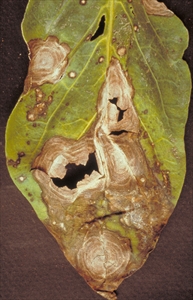Frog-eye leaf spot; stem-end rot, Cercospora leaf spot
Pacific Pests, Pathogens and Weeds - Online edition
Pacific Pests, Pathogens & Weeds
Capsicum frog-eye spot (092)
Cercospora capsici
Asia, South America, the Caribbean, Oceania, but not well documented. It is recorded from American Samoa, Fiji, Palau, Samoa, Solomon Island, Tonga, and Vanuatu.
Capsicum annuum (capsicum) and Capsicum frutescens (chilli)
The spots on the leaves are distinctive. They are brown, up to 10 mm diameter, and have a 0.5-1 mm whitish or grey centre, hence the name 'frog-eye' (Photo 1). As the spots develop, surrounding areas of the leaf start to turn yellow. In severe cases, the spots merge so that large areas of the leaves are diseased (Photo 2). Even a few spots on a leaf may result in early leaf fall (Photo 3). Spots also occur on the stems, as well as leaf and fruit stalks.
The spores of the fungus present on the underside of the leaves are spread by wind and rain.
A fungus causes the damage. In wet weather, the disease causes loss of leaves, and is likely to result in lower fruit production. In severe cases, the fungus causes a stem-end rot on the fruits.
Look for brown roughly circular spots with whitish centres, and yellow halos.
CULTURAL CONTROL
Before planting:
- Practice crop rotation. Do not plant one crop of capsicum or chilli after another on the same land. Leave at least 3 years between crops after the disease has occurred.
- Do not plant new crops near those with frog-eye disease.
- The fungus is seed borne. Make sure fruits selected for seed do not have stem-end rots.
After harvest:
- Collect the remains of the crop and burn them. The fungus can survive in crop debris
RESISTANT VARIETIES
None known.
CHEMICAL CONTROL
Warm wet conditions favour the disease, and fungicides may be needed to give adequate control. Do the following:
- Use chlorothalonil, copper oxychloride or mancozeb.
- Treatment should start when the spots first appear, and continue at 10-14 days intervals until 3-4 weeks before last harvest.
- It is important to spray both sides of the leaves.
____________________
When using a pesticide, always wear protective clothing and follow the instructions on the product label, such as dosage, timing of application, and pre-harvest interval. Recommendations will vary with the crop and system of cultivation. Expert advice on the most appropriate pesticides to use should always be sought from local agricultural authorities.
AUTHORS Helen Tsatsia & Grahame Jackson
Information from McKenzie E (2013) Cercospora capsici: PaDIL - http://www.padil.gov.au. Photo 2 Kohler F, et al. (1997) Diseases of cultivated crops in Pacific Island countries. South Pacific Commission. Pirie Printers Pty Limited, Canberra, Australia; and from Cercospora leaf spot (2013) Department of Agriculture and Fisheries. Queensland Government. (https://www.daf.qld.gov.au/business-priorities/agriculture/plants/fruit-vegetable/diseases-disorders/cercospora-leaf-spot).
Produced with support from the Australian Centre for International Agricultural Research under project PC/2010/090: Strengthening integrated crop management research in the Pacific Islands in support of sustainable intensification of high-value crop production, implemented by the University of Queensland and the Secretariat of the Pacific Community.






